Machinery investment for profitable grain maize
18th November 2022
An Essex farmer who grew grain maize for the second time this year says the crop is so profitable and provides so many benefits for his operation that he has invested in his own specialist machinery to harvest it. David Williams visited the farm.
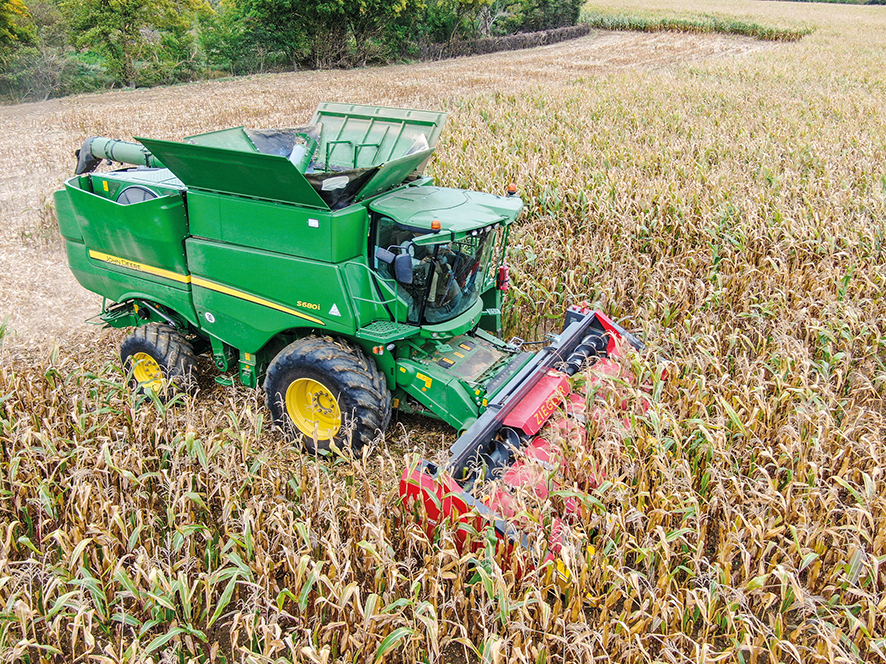
Essex farmer James Nott has invested in a Ziegler maize header for his John Deere combine to harvest a large acreage of grain maize.
James Nott grew a small area of grain maize as a trial in 2021, which was harvested on the 10th November. A contractor drilled the maize and a combine with a maize header was borrowed from a nearby farmer who has grown the crop for several years.
“One of the main issues affecting the crop’s popularity in the UK is that many farmers don’t want to be combining in October,” explained James, who farms near Clare. “As a break crop which also allows growers to tackle black-grass, you couldn’t ask for more. It’s profitable and easy to harvest, and there is far less risk of damaging the ground harvesting in a wet autumn than there would be growing crops such as sugar beet.
“There is a small fusarium risk, but that is easily managed.”
Conventional combine
“We use John Deere combines, and similar machines are used extensively in the USA for maize harvesting,” continued James. “We have a large X9-series and ordered a Ziegler 12-row maize header to suit it from Tuckwells, our local John Deere dealer. However, the header wasn’t available in time for the 2022 harvest so the Ziegler UK importer, Abrey Agricultural Ltd, lent a smaller 8-row header instead. We borrowed an S-series combine from Tuckwells to match it and, apart from the maize header, the only change from standard specification was fitting a large-wire concave for optimal performance, although the standard version would have been adequate for a smaller acreage.”
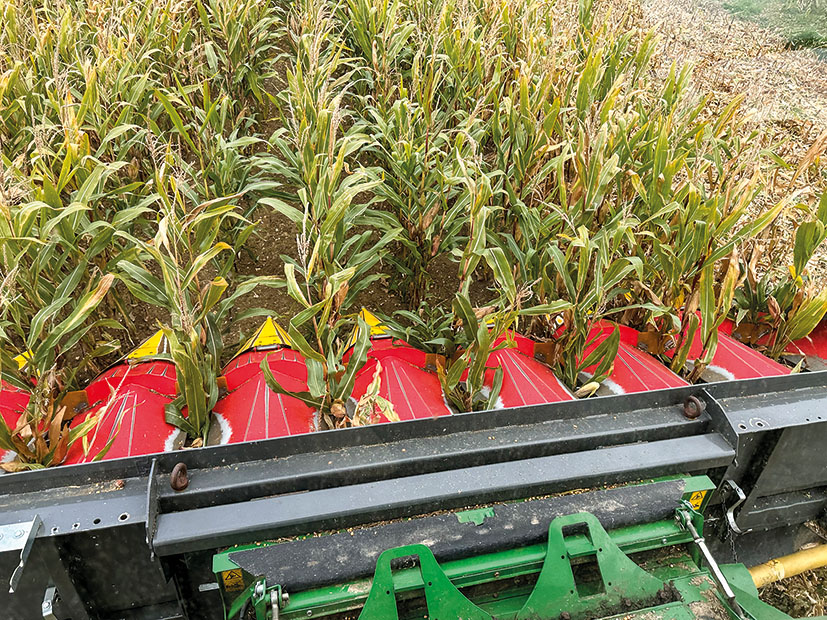
Only the cobs and surrounding leaves are taken into the combine. The stalks and most of the other leaves pass under the header where they are chopped by rotating blades and left as a mulch on the ground.
Easy to harvest
James said that an advantage of maize is that once the cobs have ripened and dried, the waxy seeds don’t re-absorb moisture. “When the crop is ripe, it’s harvested at 30–35% moisture. If it rains, then we wait a few hours for the leaves to shed the water, then harvesting continues.”
Ground protected
Only the cobs go through the combine. They are stripped from the rest of the plant, pulled into the header by paddles and small augers, and transferred to the intake elevator by the main auger. The plant stem and leaves pass below the header where they are chopped by rotating knives and form a thick mat of maize stover on the ground. “This is an advantage for autumn harvesting, as the combine wheels, and tractor and trailer wheels travel on the stover rather than on bare ground. The wheels are supported and remain clean, and there is far less tendency to create ruts than when harvesting root crops at the same time of year. It also means that we incorporate a large amount of organic matter which would be lost when growing maize for energy production.”
The maize must be dried to approximately 15% moisture which requires heat. James said that a batch dryer is his preferred option, although last year he successfully used his main continuous-flow dryer. Drying floors aren’t generally suitable.
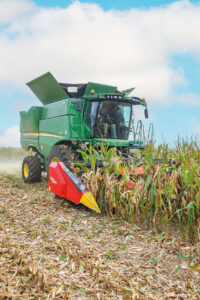
James has ordered a 12-row Ziegler header for his own John Deere X9-series combine for next year. For the 2022 harvest, an 8-row header was loaned by Ziegler importer Abrey Agricultural Ltd, to fit a John Deere S680i combine borrowed from local dealer Tuckwells.
Profitable crop
Yields last year were between 8–12t per hectare. “We are looking for 10t/ha generally and the crop sells currently at approximately £315/t. The seed rate is only 75% of what is needed for forage maize. We put on 140kg of nitrogen, and drying it cost £40 per tonne this year. This leaves a very good margin to grow, harvest and store it while still making a good profit.”
Maize header demand grows
“Demand for maize headers has increased considerably, as more growers are recognising benefits of the crop,” explained Abrey Agricultural Ltd managing director Toby Abrey. “Ziegler headers have a superb reputation, although in the UK the brand is better known for its range of conventional combine header trailers. We import these and supply them through dealers for all the main combine brands, so when customers ask their dealers for maize headers, ours are the obvious choice.”
Toby said that a folding maize header displayed on his company’s stand at Lamma this year created a lot of interest. “With climate change as well as development of new maize varieties which are even better suited to UK conditions, and a ready market – they are likely to become a popular break crop.”
James considered several brands of header before ordering his 12-row Ziegler. “The combine and header we borrowed for the 2021 maize harvest did a good job, but we already have a Ziegler trailer for our 45ft conventional header and remain impressed by its build quality and performance. We have known Toby Abrey for many years and get on with him well, so buying the Ziegler header through Tuckwells which also supplies and looks after our combines was the obvious choice.”
Drought tolerance
As new maize varieties are developed, James believes more farmers will grow the crop. “Although it’s easy to harvest, even in a wet autumn, I think that most farmers would want to be sure of clearing the fields before the end of October,” he said. “We hosted new variety trials on our farm, working with Pioneer Seeds, which proved interesting. The main thing we need is standing power, and most of our crop this year was Likeit with a standing power of nine and it stayed up well. New varieties also offer increased eyespot and fusarium resistance.”
James said that to guarantee a good crop, a proper seedbed and a decent drill with accurate depth control are needed. “Like most other areas of the UK we suffered with drought conditions throughout spring and summer, and I will admit to having been a little concerned about the maize – even though it’s a very hardy crop. The field had an application of digestate and I think that helped, and we saw the crop fill out later in the summer when the rain arrived so that by the time it was harvested in early October the cobs were a decent size and we achieved the yields we had hoped for.”
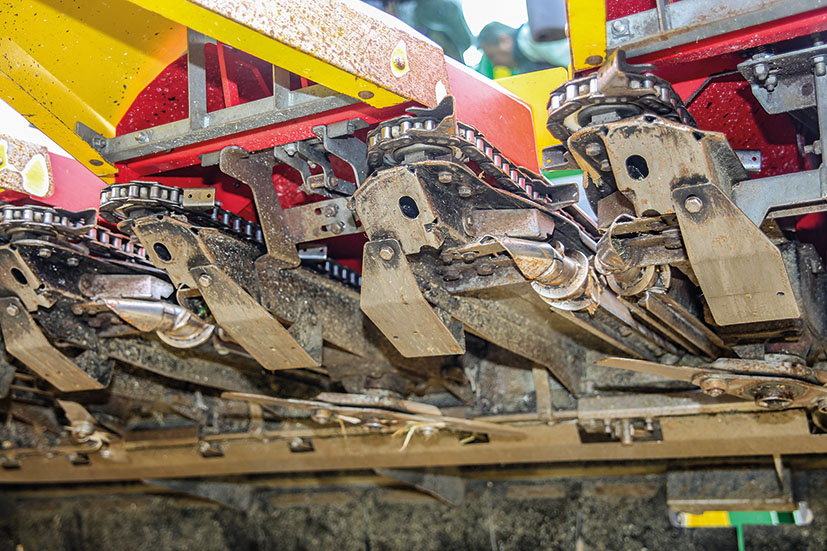
The underside of the header – paddles and augers draw the maize into the front of the header. The cobs are stripped away, and the rest of the plant passes under the header and is chopped.
The right range to supply
Tuckwells Group harvesting product specialist Steve Buckett said that although several of his customers have grown small areas of grain maize for many years for use on-farm as feed, he believes the market has the potential to grow rapidly now. “In our trading area there is a lot of interest, and I believe that this will be boosted by James’ involvement. We are well placed to support those growing the crop. What John Deere doesn’t know about harvesting maize isn’t worth knowing.”
Grain maize is a no-brainer
Current high energy prices and potential fuel shortages mean that maize for AD plants is also likely to be in high demand. This provides an alternative sales option for maize in the field. “If prices are high enough in future years, then we could sell standing crop for forage rather than harvesting it ourselves for the grain, but we would need a good premium due to the disadvantages of removing so much organic matter as well as the increased risk of compaction and rutting.
“We believe that growing maize for the grain has a lot of potential and compared to break crops such as beans it really is a no-brainer.”
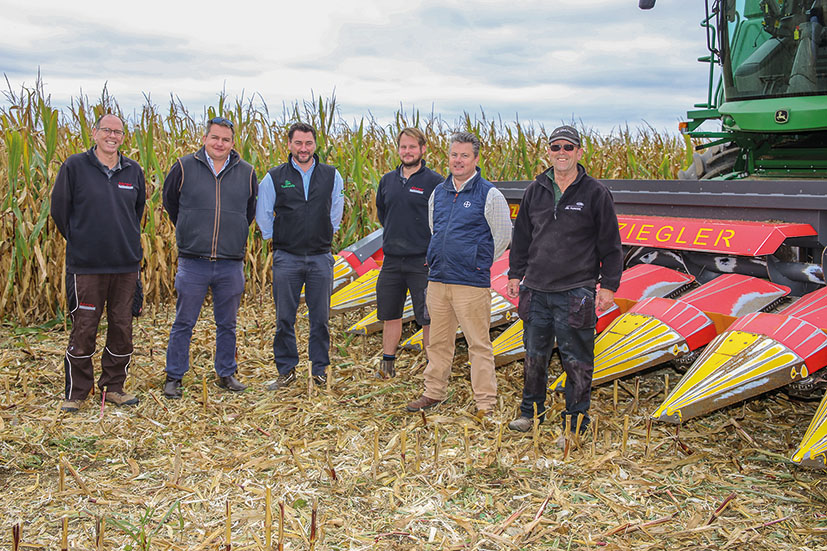
Pictured (l-r) Toby Abrey; Tuckwells Dunmow depot-based area sales manager Tim Thornton; Steve Buckett; Abrey Agriculture Ziegler specialist Lewis Thake; James Nott; and Gerald Williams who managed the Pioneer Seeds variety trials on the farm.
